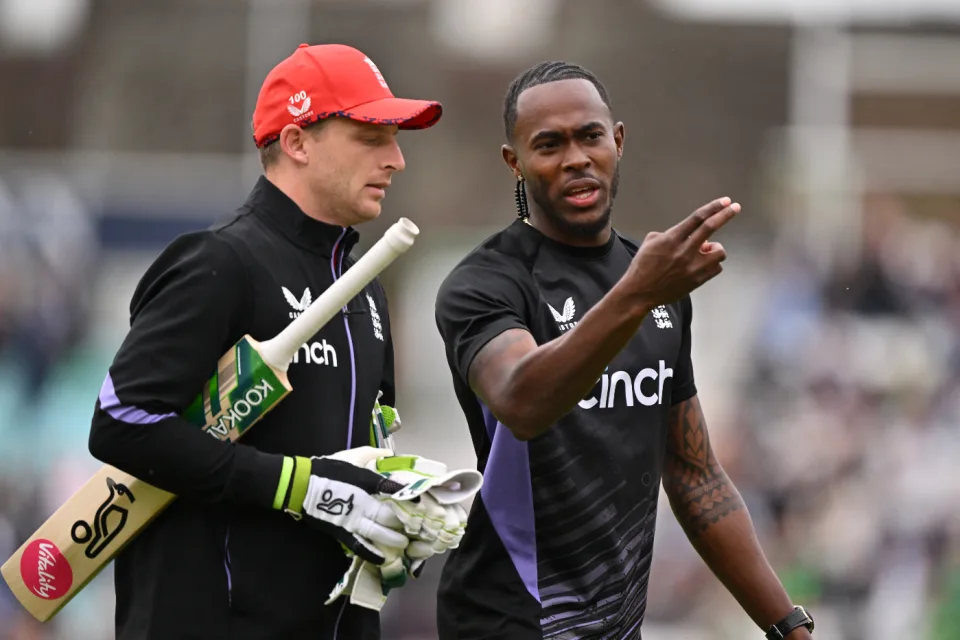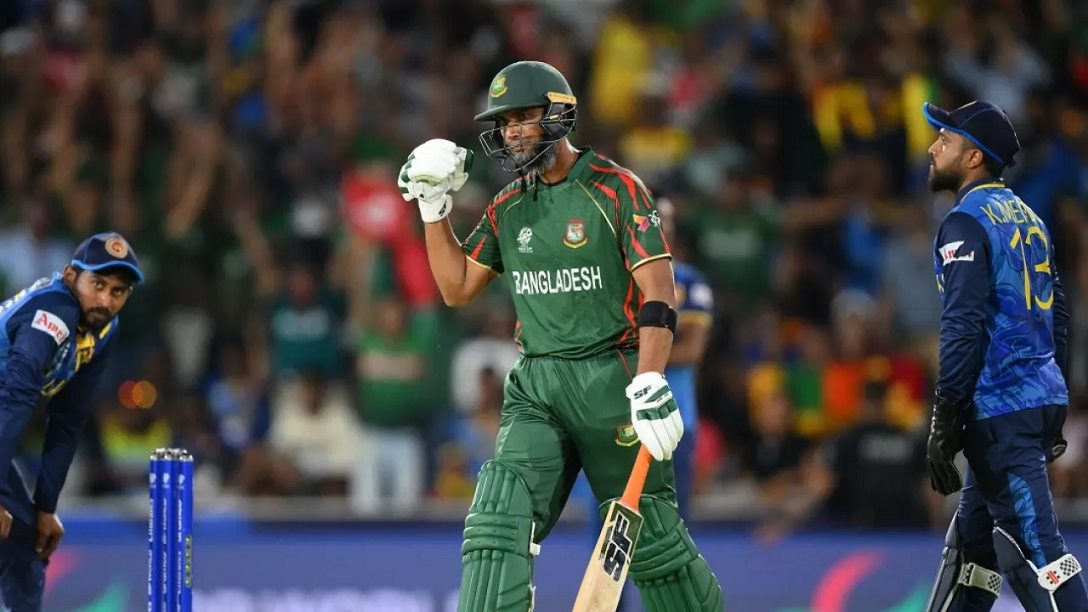Sports
Brydon Carse makes his mark on debut as England power to seven-wicket victory

England’s rejigged T20I team powered out of their mothballs with a crushing seven-wicket victory under the floodlights at Chester-le-Street, as they hunted down a sub-par target of 140 with six full overs to spare.
A fine home-town debut from the seamer Brydon Carse denied New Zealand any momentum despite a misleadingly run-laden first over from Finn Allen, whereupon a brace of forceful knocks from Dawid Malan and the inevitable Harry Brook allowed Jos Buttler to sit back in the dressing-room with his feet up, resting up for more meaningful contests to come.
In their first white-ball outing since the tour of Bangladesh in March, England showed once again that their depth of options is second-to-none in the world game. Despite losing two prospective fast-bowling debutants, Josh Tongue and John Turner, to injury, and resting a third, Gus Atkinson, for later in the series, England’s line was led instead by Carse and the left-armer LukeWood, who claimed three wickets apiece.
In reply England never looked like letting their grip on the contest slip, despite the first-over loss of Jonny Bairstow, and once Malan had anchored the chase with his 17th fifty-plus score in 56 T20I innings, Brook and Liam Livingstone, with a huge blow for six over deep midwicket, closed out the chase in short order.
Allen’s most recent on-field act, in the green of Southern Brave, had been to slam 69 from 38 balls in a riotous (but unsuccessful) opening onslaught in last week’s Hundred Eliminator. And so the die seemed to have been cast when he climbed into a massive yahoo at Wood’s second delivery of the match. He didn’t connect on that occasion, but each of the next three flew out of the park – one down the ground, two high over midwicket – in an apparent signal of another powerplay charge.
What followed, however, was a near-complete lockdown from England’s new-look seam attack. Sam Curran applied the handbrake with a five-run second over before the debutant Carse conceded a solitary run off the bat with his relentless deck-thumping approach.
A switch of ends for Wood then paid early dividends as Devon Conway snicked a drive with no footwork to fall for 3 from 8, and after Carse had burst through Allen’s defence with an 87mph leg-stump-seeker, Wood made it two in three overs as Tim Seifert was suckered by the angle from round the wicket to lose his off stump for 9.
With the introduction of spin in the seventh over, New Zealand’s innings suffered a similar false dawn. Mark Chapman picked Adil Rashid’s first-ball legbreak and smoked him over midwicket for six… but his team managed just five more runs in the next nine before Moeen Ali, a scourge of left-handers, bowled Chapman with a beauty that held its line from round the wicket to take the top of off stump.
At 49 for 4, New Zealand were once again in need of a big performance from Daryl Mitchell, but on this occasion, even his long levers couldn’t turn the tide. Liam Livingstone entered the attack with a startlingly sharp legbreak that leapt past Mitchell’s edge, and – seemingly spooked – Mitchell climbed through the line of his very next ball, but could only pick out Brook on the long-off boundary. Rashid was then rewarded for an unremarkably excellent three-over spell with the soft dismissal of Mitchell Santner, who toe-ended a cut to point.
Thereafter, it was all about the scramble to the bottom of the innings. Glenn Phillips was New Zealand’s best hope of a competitive total, but his subdued 41 from 38 was ended by the sharpest take of the innings, as Curran in the covers read the fade on a sliced drive at a Wood slower ball, and leapt to his left to cling on in both hands.
Adam Milne and Ish Sodhi then landed a six apiece off consecutive balls to at least hoist England’s target past a run a ball, but Carse was on hand to shut down the innings in style. His first ball of the 20th over was an inch-perfect offcutter, on that hard in-between length that skidded past Milne’s wipe to leg; his fifth was fired into the toes, demanding that Sodhi took on the longest boundary, and he duly failed.
Carse had opened his account with 1 for 3 in his first two overs. Now he closed the innings down with 3 for 23 all told, his best in all T20s, and delivered with that familiar pitch-battering poise that Liam Plunkett once brought to England’s white-ball attack. For a man who wasn’t initially picked for this T20I squad, it was quite the way to celebrate becoming England’s 100th cap in the format.
Buttler will doubtless be back to the top of the order come England’s defence of their T20 title in the Caribbean and the USA next June, but his self-demotion to No. 6 was an acknowledgement that others have greater points to prove with the 50-over version looming.
There’s Bairstow for example – Buttler’s intended opening partner in Australia last winter until his horrific leg injury, and the man expected to front up alongside Jason Roy in India in five weeks’ time. His first England white-ball innings in 13 months at least came at a 200 strike-rate: a first-ball pump for four through midwicket, then a second-ball snick to slip off Tim Southee, after a leg-side wide for good measure.
There’s Will Jacks too, a potential travelling reserve in India, and a definite candidate for T20 opening honours, after his trophy-winning exploits (with bat and ball) for Oval Invincibles in the Hundred this month. His lacerating power was on full display once more as he greeted Lockie Ferguson’s first over with two fours and an inside-out carve for six, and having ignited a 61-run powerplay with 22 in 11 balls, he muffed a pull off Sodhi from his very next ball.
With his habitual faith in his own acceleration, Malan turned a doughty innings of 4 from 10 balls into a formidable 40-ball half-century, with five fours and two sixes – each of them mown with awesome power over the leg side off Sodhi and Santner respectively. He looked aghast to give it away at 54 from 42, but at 116 for 3 in the 13th over, he’d already drained the contest of any jeopardy.
And then, inevitably, there was Brook. The most notable absentee from England’s World Cup plans was clinically violent in belting them over the line with 43 not out from 27 balls, including back-to-back blats for six off Sodhi, over cover and midwicket respectively, and a third massive launch over the ropes as Southee served up a slower ball and was made to travel the distance. Whether it’s too late for him to change any minds that matter, only the selectors know for sure. But on this occasion, he barely broke sweat in looking a class apart.
Brief scores:
England 143 for 3 (Malan 54, Brook 43*) beat New Zealand 139 for 9 (Phillips 41, Carse 3-23, Wood 3-37) by seven wickets
Sports
England face Australia in the battle of champions

The first truly heavyweight clash of this expanded T20 World Cup format comes freighted with both history and subplots. A rematch of the 2010 World T20 final at Kensington Oval, the match pits Jos Buttler’s defending champions – who are aiming to become the first team to retain the trophy – against the Australian winning machine, victors at the 2021 edition and current world title-holders in Test and ODI cricket. And that’s before you throw in the Ashes for afters.
Already there is added pressure on England, after the rain in Bridgetown led to a share of the points in their opener against Scotland (and that having conceded 90 runs from 10 overs without taking a wicket in a tepid bowling display). Lose to their oldest rivals and it will leave their Super 8 prospects open to being waylaid by the perils of net run-rate calculations, or worse.
The Scotland match was the third abandonment in five suffered by England, after a rain-affected home series against Pakistan, which has clearly hampered their readiness for this campaign after almost six months without playing T20 together. It does not take much for a side to click in this format – and England looked in decent shape when they did get on the field against Pakistan – but Buttler will be anxious for things to go their way on Saturday, if only to avoid further questions referencing the team’s disastrous ODI World Cup defence last year.
Australia, under the laidback leadership of Mitchell Marsh would love nothing more than to add to the English sense of jeopardy – having helped bundle them out of the tournament in India on the way to taking the crown. Their head to head record is less impressive in T20 however, with England having won six of the last seven completed encounters, as well as that 2010 final.
Despite a wobble with the bat, Australia avoided mishap against Oman earlier in the week, the experience of David Warner and Marcus Stoinis shining through in difficult batting conditions. Surfaces in the Caribbean – not to mention those games staged in the USA – have already had teams scratching their heads; rather than the “slug-fest” England had prepared for, following a high-scoring tour of the Caribbean in December, it looks as if boxing smart may be the way to go.
Speaking of Warner, this could be the last time he faces up against England in national colours – and another match-winning contribution would likely reduce the chances of them meeting again in the knockouts. On the other side of the card is Jofra Archer, fresh from an emotional maiden outing at Kensington Oval and ready to take on Australia for the first time in any format since 2020. Can Mark Wood fire up England’s campaign, as he did during last summer’s Ashes? Will Pat Cummins be back to harass the old enemy once again? Seconds out, it’s almost time to rumble.
Cummins is set to return after being rested for the Oman game, which saw Mitchell Starc leave the field with cramp. Starc is understood to be fine and could keep his place – which would likely see Nathan Ellis miss out. Marsh is still not fit to bowl, with Australia likely to continue with the allrounder combination of Stoinis and Maxwell to give them cover.
Australia (probable XI): David Warner, Travis Head, Mitchell Marsh (capt), Glenn Maxwell, Marcus Stoinis, Josh Inglis (wk), Tim David, Pat Cummins, Nathan Ellis/Mitchell Starc, Adam Zampa, Josh Hazlewood
The one change England may consider is Reece Topley coming in for Wood, with the expectation that there will be some rotation among the seamers through the course of the tournament.
England (probable XI): Phil Salt, Jos Buttler (capt & wk), Will Jacks, Jonny Bairstow, Harry Brook, Liam Livingstone, Moeen Ali, Chris Jordan, Jofra Archer, Adil Rashid, Reece Topley/Mark Wood
[Cricinfo]
Sports
South Africa up against their bogey team in batter-unfriendly New York

Once is coincidence, twice is a clue, and three times is proof.
To paraphrase Agatha Christie, that is the narrative around South Africa’s meeting with Netherlands at this T20 World Cup.
The Dutch beat South Africa at the 2022 tournament and ended their semi-final hopes in a match where South Africa appeared to be sleep walking, and then beat them again at the 2023 ODI World Cup, where they exposed South Africa’s vulnerability in the chase. If they to do the treble, not only will Netherlands take the lead in Group D, but they will offer conclusive evidence of the threat they pose to Full Members, especially South Africa.
Of course, it will take some doing after South Africa’s opening performance against Sri Lanka, where they reduced their opposition to their lowest T20I total and chased it down in fairly straightforward fashion thanks to the most stable middle-order of their white-ball era. In Aiden Markram, Tristan Stubbs, Heinrich Klaasen and David Miller, South Africa have bankers and big-hitters and, for this match, they also have the advantage of experience. They’ve already played at Eisenhower Park, and have first-hand knowledge that run-scoring doesn’t come easily;Klassen said they are prepared to use their “cricket brains” and play “smarter cricket”.
But the conditions could be good news for Netherlands, who are not naturally a line-up of big hitters and build their innings on a foundation of turning ones into twos. In other words, they tend to take a slightly more conservative approach to batting, which may work well here, but they’ll be wary of the uneven bounce of the surface and will have to come up with plans to counterattack especially against South Africa’s seamers. Their own bowlers were exemplary in Dallas and will look to build on that performance against a line-up that will likely be more proactive than Nepal’s, but who they have managed to keep quiet not once, but twice in the past. Third time’s the charm, they say.
Anrich Nortje’s stunning return to form against Sri Lanka means South Africa may not have to tinker with the bowling combination, and Gerald Coetzee and Tabraiz Shamsi may have to wait their turns to get a game. The batting line-up should be unchanged, with no space for Ryan Rickelton yet.
South Africa: Quinton de Kock (wk), Reeza Hendricks, Aiden Markam, Tristan Stubbs, Heinrich Klaasen (wk), David Miller, Marco Jansen, Keshav Maharaj, Kagiso Rabada, Ottneil Baartman, Anrich Nortje
Conditions in New York may tempt Netherlands to include an extra seamer and they have Kyle Klein in their squad. But it could come at the expense of a shortened batting line-up and they may not want to risk that.
Netherlands: Michael Levitt, Max O’Dowd, Vikramjit Singh, Sybrand Engelbrecht, Scott Edwards (capt, wk), Bas de Leede, Teja Nidamanuru, Logan van Beek, Tim Pringle, Paul van Meekeren, Vivian Kingma
[Cricinfo]
Latest News
Mustafizur, Rishad, Hridoy dazzle in Bangladesh’s tight two-wicket win over Sri Lanka

Nuwan Thushara’s last over brought Sri Lanka screaming back into the match,as he first bowled Rishad Hossain, and then nailed Taskin Ahmed in front of the stumps with a pinpoint swinging yorker. This left Bangladesh eight wickets down, with 12 runs still to get.
However, the experienced Mahmudullah was at the crease for Bangladesh, and despite some further nervy moments, pushed Bangladesh across the line off the last ball of the 19th over.
But this was a match chiefly decided by Bangladesh’s own outstanding bowling. Mustafizur Rahman was the best among them, using shorter lengths and his cutters efficiently, to claim figures of 3 for 17. Rishad Hossain’s three-for through the middle overs also kept Sri Lanka quiet.
Mustafizur was instrumental in Sri Lanka’s downward spiral through the middle overs, which culminated in a crash-and-burn end. Ultimately, their inability to find boundaries, or even rotate strike against good Bangladesh bowling resulted in their downfall. A score of 125 for 9 always seemed poor on a decent pitch, even if their bowlers made a match of it in the end.
Brief scores:
Bangladesh 125 for 8 in 19 overs (Towhid Hridoy 40, Litton Das 36; Dhanajaya de Silva 1-11, Nuwan Thushara 4-18, Wanidu Hasaranga 2-32, Matheesha Pathirana 1-27) beat Sri Lanka124 for 9 in 20 overs (Pathum Nissanka 47, Dhananjaya de Silva 21; Tanzim Hasan Sakib 1-24, Taskin Ahmed 2-25, Mustafizur Rahman 3-17, Rishad Hossain 3-22) by two wickets
[Cricinfo]












